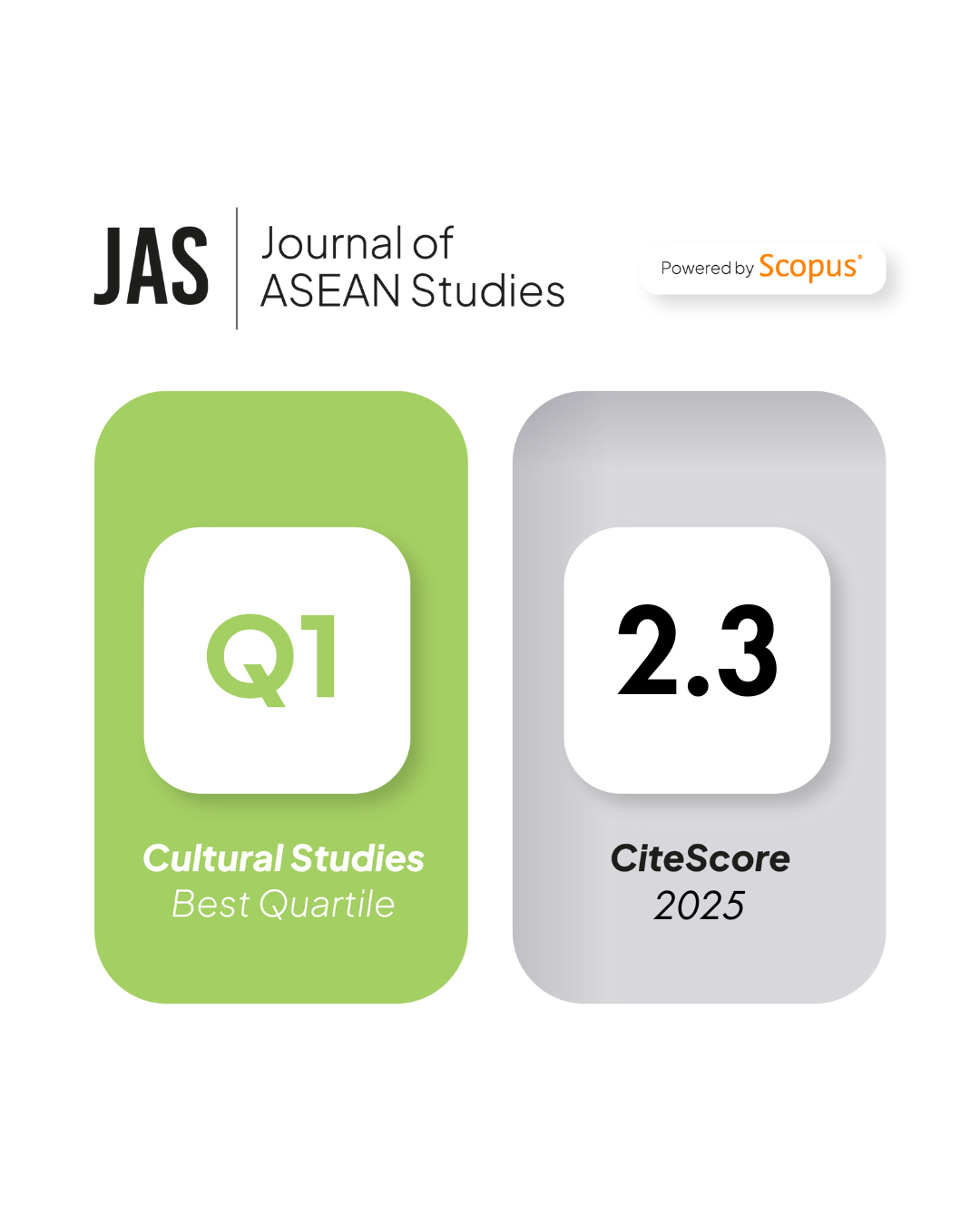Increasing Economic Interdependence between China and ASEAN and Its Implications
DOI:
https://doi.org/10.21512/jas.v4i2.1524Keywords:
economic interdependence, TPP, One Belt One Road, ASEAN Economic Community, 2 7 Cooperation Framework,Abstract
This paper aims to study the problems and issues of China's relations with ASEAN, which has achieved the establishment of ASEAN Economic Community by 2015. Taking into consideration the institutional framework constituted by the multiple agreements signed between China and ASEAN, how will the development of China-ASEAN relations be influenced by increasing economic interdependence between the two? What will be the difficulties ahead in enhancing trade and investments? Does promoting economic cooperation lead to more mutual trust in the political-strategic arena? China's recent policy in developing "one belt, one road", and Chinese relations to the US-led Trans-Pacific Partnership and their implications to ASEAN will also be examined in this paper.References
ASEAN Economic Economic Blueprint, 2007, see http://www.asean.org/archive/5187-10.pdf
ASEAN-China Centre, http://www.asean-china-center.org/english/2010-06/23/c_13365143_2.htm
Statistics of ASEAN, http://www.asean.org/images/2015/June/FDI_tables/Table%2027.pdf
“Top Ten ASEAN Trade Partner Countries/Regions, 2014â€, ASEAN External Trade Statistics, http://www.asean.org/images/2015/July/external_trade_statistic/table20_as of 17June15.pdf.
“China: Exports and Importsâ€, Direction of Trade Statistics, International Monetary Fund, 2015
Chinvanno, Anuson, “ASEAN-China Relations: Prospects and Challengesâ€, RJSH, Vo. 2, No. 1, Jan-Jun 2015, p. 13.
Donnan, Shawn, “Trade Deal Takes Aim at Chinese Hackingâ€, Financial Times, 5 November 2015, p. 2.
Fan, Ying, “What can ACFTA Share with FTAAP?â€, in K. E. Flick & K. M. Kemburi eds., ASEAN-China Free Trade Area: Challenges, Opportunities and the Road Ahead, RSIS Monograph No. 22, S. Rajaratnam School of International Studies, Nanyang Technological University, Singapore, 2012, p. 109.
Goh, Evelyn, “Great Powers and Hierarchical Order in Southeast Asia: Analysing Regional Security Strategiesâ€, International Security, Vo. 32, No. 3, Winter 2007/2008, pp. 113-157.
Gu, Guoping, “The defects of ‘On the Threat from Chinese Soft Powerâ€: the Case of Southeast Asiaâ€, Dongnanya Yanjiu (Southeast Asian Studies), 4, 2013, pp. 32-40
Hatakeyama, Noboru, “ACFTA in the Context of Asia-Pacific Economic Relationsâ€, in K. E. Flick & K. M. Kemburi eds., ASEAN-China Free Trade Area: Challenges, Opportunities and the Road Ahead, RSIS Monograph No. 22, S. Rajaratnam School of International Studies, Nanyang Technological University, Singapore, 2012, p. 105.
Jiang Jialin & Cai Li, “Analysis of Trade Development between China and Association of Southeast Asian Nationsâ€, Journal of Behavioural Economics, Finance, Entrepreneurship, Accounting and Transports, Vol. 1, No. 1, 2013, p. 16
Prashanth Parameswaran, “Beijing Unveils New Strategy for ASEAN-China Relationsâ€, in China Brief, The Jamestown Foundation, Vol. 13, No. 21, 24 Oct 2013, p. 12.
Premier Li Keqiang's keynote speech at 10th China-ASEAN Expo,
http://english.mofcom.gov.cn/article/zt_10thchina/column1/201309/20130900287593.shtml
Report on the transfer of electricity from Southern China to ASEAN countries, http://www.chinapower.com.cn/newsarticle/1236/new1236790.asp
Soerakoesoemah, Rony, “ASEAN-China Free Trade Areaâ€, in K. E. Flick & K. M. Kemburi eds., ASEAN-China Free Trade Area: Challenges, Opportunities and the Road Ahead, RSIS Monograph No. 22, S. Rajaratnam School of International Studies, Nanyang Technological University, Singapore, 2012, p. 19.
Salidjanova, Nargiza, & Iacob Koch-Weser with Jason Klanderman, “China’s Economic Ties with ASEAN: a Country-by-Country Analysisâ€, US-China Economic and Security Review Commission, Staff Research Report, March 17, 2015, p. 5.
Wang Xiaoke & Zhang Huizhi, “Great Power Competitions and China’s Economic Diplomacy towards Southeast Asiaâ€, Dongnanya Yanjiu (Southeast Asian Studies), 1 2015, pp. 27-32.
Website of Trading Economics: http://www.tradingeconomic.com/china/foreign-currency-reserves
Wei Min, “Constructing the ‘Upgraded Version’ of China-ASEAN Free Trade Area: Problems and Perspectivesâ€, Guoji Wenti Yanjiu (International Studies), 2, 2015, pp. 127-140.
Wu Jiansheng & Qu Fengjie, “TPP: Trends, Influence and Strategic Policy Reactionsâ€, Guoji Jingji Pinglun (Review of International Economics), No.1, 2014, p. 67
Zhang Xiaoqin, “The Operational Performance of the China-ASEAN Free Trade Area and its sustainable Development Pathâ€, Xiandai Guoji Guanxi, (Contemporary International Relations), 7, 2015, p. 28.






















